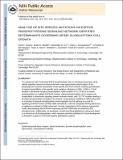ANALYSIS OF SITE-SPECIFIC MUTATIONS ON EGFRVIII PHOSPHOTYROSINE SIGNALING NETWORK IDENTIFIES DETERMINANTS GOVERNING U87MG GLIOBLASTOMA CELL GROWTH
Author(s)
Huang, Paul H.; Miraldi, Emily Rae; Xu, Alexander M.; Kundukulam, Vibin Anto; Flynn, Ryan A.; Cavenee, Webster K.; Furnari, Frank B.; White, Forest M.; Del Rosario, Amanda M; ... Show more Show less
DownloadWhite_Analysis site-specific.pdf (1.231Mb)
OPEN_ACCESS_POLICY
Open Access Policy
Creative Commons Attribution-Noncommercial-Share Alike
Alternative title
Phosphotyrosine signaling analysis of site-specific mutations on EGFRvIII identifies determinants governing glioblastoma cell growth
Terms of use
Metadata
Show full item recordAbstract
To evaluate the role of individual EGFR phosphorylation sites in activating components of the cellular signaling network we have performed a mass spectrometry-based analysis of the phosphotyrosine network downstream of site-specific EGFRvIII mutants, enabling quantification of network-level effects of site-specific point mutations. Mutation at Y845, Y1068 or Y1148 resulted in diminished receptor phosphorylation, while mutation at Y1173 led to increased phosphorylation on multiple EGFRvIII residues. Altered phosphorylation at the receptor was recapitulated in downstream signaling network activation levels, with Y1173F mutation leading to increased phosphorylation throughout the network. Computational modeling of GBM cell growth as a function of network phosphorylation levels highlights the Erk pathway as crucial for regulating EGFRvIII-driven U87MG GBM cell behavior, with the unexpected finding that Erk1/2 is negatively correlated to GBM cell growth. Genetic manipulation of this pathway supports the model, demonstrating that EGFRvIII-expressing U87MG GBM cells are sensitive to Erk activation levels. Additionally, we developed a model describing glioblastoma cell growth based on a reduced set of phosphoproteins, which represent potential candidates for future development as therapeutic targets for EGFRvIII-positive glioblastoma patients.
Description
available in PMC 2012 March 1.
Date issued
2010-05Department
Massachusetts Institute of Technology. Computational and Systems Biology Program; Massachusetts Institute of Technology. Department of Biological Engineering; Koch Institute for Integrative Cancer Research at MITJournal
Molecular BioSystems
Publisher
Royal Society of Chemistry
Citation
Huang, Paul H. et al. “Phosphotyrosine Signaling Analysis of Site-specific Mutations on EGFRvIII Identifies Determinants Governing Glioblastoma Cell Growth.” Molecular BioSystems 6.7 (2010): 1227. Web.
Version: Author's final manuscript
ISSN
1742-206X
1742-2051